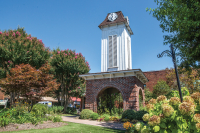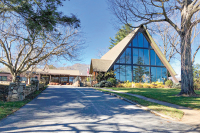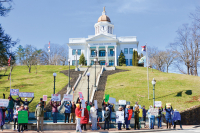Building a home: A timeline of Kory Wawanaca
 2003
2003
Carrie Blackburn Brown, who eventually founded Kory Wawanaca Children’s Home, graduated from Appalachian State University with degrees in dance and Spanish and a general desire to spend a few months abroad volunteering.
The Peace Corps was out, obviously, because two years was too big a commitment. Instead, she followed the advice of her church’s missions minister and spent seven months volunteering at the front desk of a health clinic near La Paz in the South American country of Bolivia.
One and done. When her commitment ended, she returned to the United States, rented an apartment, got a job and set her sights on eventually enrolling in a graduate counseling program.
Feb. 2005
Brown’s church, Central United Methodist in Asheville, started planning a three-month trip to Bolivia starting in February. They started “pressuring” Brown to come along as a translator, but she said no. She’d already been back for a month the year before, and she didn’t have the $750 she’d need to return.
Related Items
“I said, ‘OK God, fine, if you want me to go back to Bolivia so bad, I need $750 and I don’t want to lose my job,’” Brown recalls.
The next day, she took a cold call from a woman who needed someone to stay with her teenage children for 10 days. The job would pay exactly $750. When the hotel where she worked announced that someone would have to take a voluntary three-month layoff — the exact three months Brown would be gone — she knew “I wouldn’t be coming back to my stable life, that there would be something more.”
So, she paid attention during the three-month stay, observing the country’s social and economic problems through the lens of what she might do to help.
Spring 2005
When Brown got back to the U.S., she’d decided what to do: save up $10,000 to take to Bolivia with a two-year commitment. She’d reached the $5,000 mark when her dad got a check in the mail — from someone who had no knowledge of Brown’s plan — for $5,000 more. It was hers, the note said, as long as she went back to Bolivia with it.
With no plan other than to just show up, Brown promptly booked a one-way flight to La Paz.
Oct. 2005
For a while, it seemed like things were going nowhere. Brown was young, a woman and a foreigner — it seemed like no one was taking her seriously. Then, she got a call from the Bolivian leadership of the United Methodist Church.
“They were saying they didn’t have a Methodist children’s home and thought that would be a great thing,” Brown said. “Me being young and naïve, I thought me and my $10,000 could build a children’s home.”
The Methodist church gave Brown a piece of land for the project, a mountainside tract in the tiny village of Tacachia. Juan Mamani, the aging survivor of Bolivia’s days of indigenous slavery who had donated the property, laughed when he saw Brown, because he’d been waiting 20 years for someone to use the land.
“I never thought it would be a little white girl,” Brown remembers him saying, “but I’m getting old and I’ll have to take what I can get.”
Brown and two helpers headed back to get started. The remote town had no running water, electricity or telephone, and they had no idea how to build anything. It would take trial and error, a willingness to look foolish and legwork to find the right people to hire, but eventually the work began.
Feb. 2006
The money ran out, so Carrie went home to fundraise. There, she discovered she no longer had to be a lone wolf.
“A lot of people were like, ‘Why waste your time working? We want to be a part of it,’” she said.
Donations, especially from the Waynesville and Asheville areas, rolled in. The children’s home wasn’t a formal organization at that point, so the money went to Brown’s personal account. She ate a lot of beans and rice during that time, she said, to avoid touching the donated dollars.
2008
Four children came to stay at the home. Three eventually went back with their parents, but the fourth, Jonatan, is now 13 and has lived at Kory Wawanaca longer than anywhere else. The transformation is phenomenal, Brown said.
“He peed himself and at night he would scream because he didn’t want to go to bed. I guess he was scared of his dreams. He stuttered really bad and you could barely understand him,” she said. “Now he’s all ‘I-love-yous’ and hugs and really stable and just a really cool, nice kid.”
2009
Brown married her husband Gavin in January, and instead of traditional wedding gifts they requested donations toward a new children’s home in the city. The school in Tacachia only went to fifth grade, and Brown wanted her teens to go somewhere where they could work toward college readiness, play a sport or learn a hobby.
“It was another God moment, because when it came time to buy a piece of land, almost to the penny of how much it cost us to buy a piece of land was how much we got from our wedding,” Brown said.
2011
The first teenagers moved into the new home in La Paz, which Gavin took on as a personal project, while volunteer groups came through to work on the unfinished sections.
The two homes aren’t isolated — the teens go out to Tacachia for retreats and to celebrate Christmas, and younger kids stay at the La Paz home when they need to travel to the city for court dates or medical attention — but on a day-to-day basis they operate separately.
Today, Kory Wawanaca has 25 kids in its family, with room for more to join.
The future
Kory Wawanaca’s legal commitment to the kids ends at age 18, but long-term Brown hopes to launch — or support someone else in launching — a transitional program to help graduates navigate a trade school or university and learn how to live on their own.
“I hate telling my story sometimes because I hate feeling like I’m tooting my own horn,” Brown said. “But I want to tell the story because if you know me at all, you know how impossible any of this was for me to do. The fact that it’s done is a true testimony to what we can do if we trust in God.”













